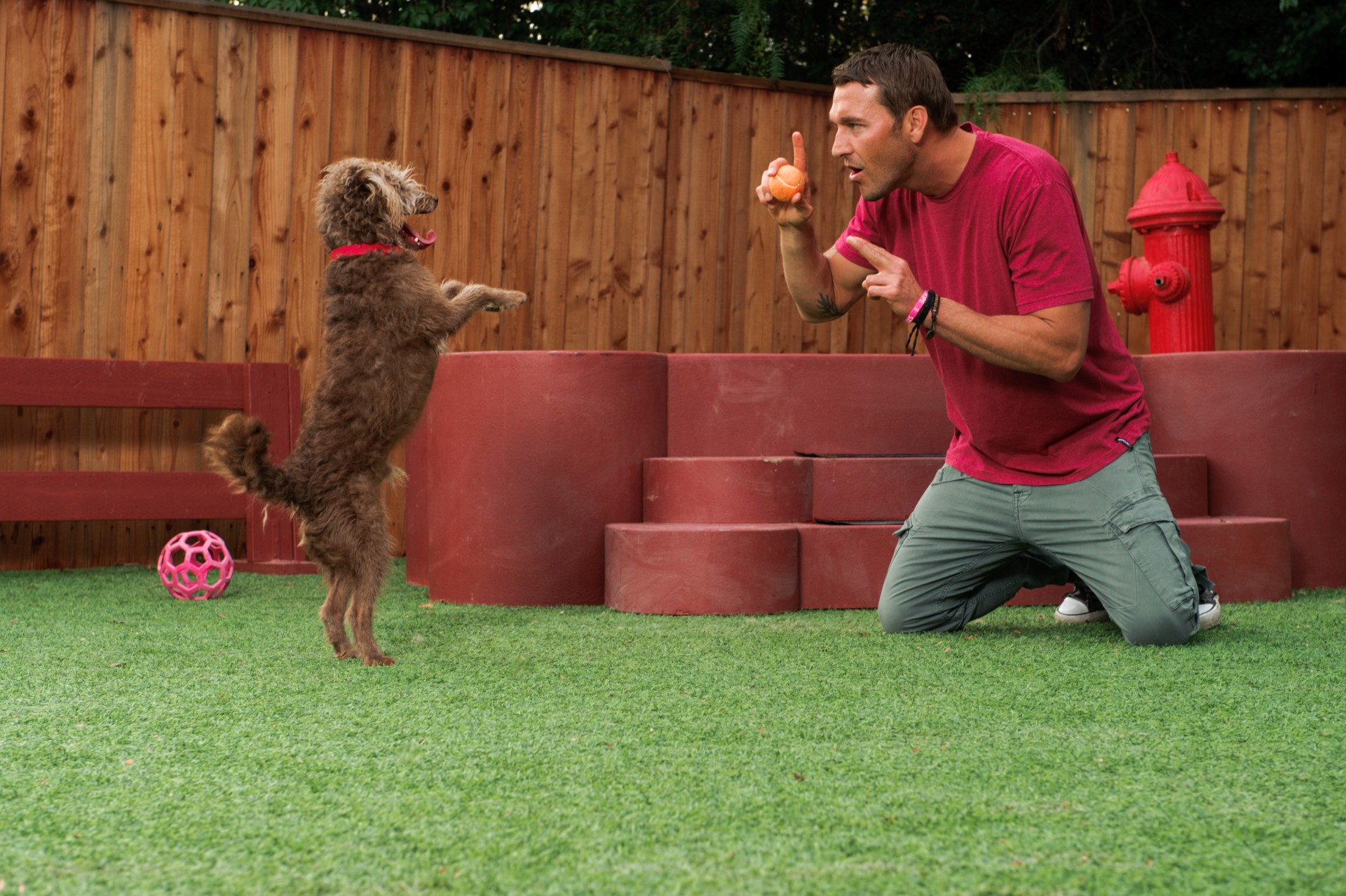
17 Jul How To Train Your Dog To Be Less Timid…
Many dogs are timid, whether they’re from a shelter or a breeder. Often it’s a personality trait ingrained in their DNA while other times it’s a learned behavior from their past history. Whatever the case may be I have a unique method that has gotten many dogs over their timidity. As with any dog there are many ways to get results but the one I’m sharing with you today I learned in my early 20’s while training dogs for television and commercials. Every time I’d have a new dog I was preparing for a life of working on a movie set I’d have to acclimate them for all the scary moving objects, sounds and people on set. I leaned the hard way a couple times by taking dogs on set that were a bit timid only to find out that stage made them twice as bad because they weren’t ready for the situations being thrown at them. I quickly devised a method to acclimate them to the worst of situations. Let’s break this down…
First thing’s first; you’ll need a few tools. You’re gonna need a bag of desirable treats, a regular leash (4 or 6 ft), and a clicker. (be sure your dog is hungry) Please note you’ll need to make sure your dog is fully clicker trained before training this. Next you’ll need the training location and this is where the magic will happen. You’ll need to go to a large hardware store like a Home Depot or Lowes. (Be sure they allow dogs. Many do, some don’t) This will be the training ground that will acclimate your dog and get them over their fears.
I want you to walk your dog to the front doors and stand outside for about 15 minutes. You’ll see a variety of possible situations that will make your dog react. Maybe it’s a person or even a shopping cart. Whatever the case may be keep a close eye on your dog, making sure to talk them through situations. When you see them react timidly to something, CALMLY talk them through it and wait them out till they settle down. Do not give them any physical affection through this as you want them to learn to stand on their own 4 paws and work through situations. When they’re tense keep waiting them out. When you see them calm down for a couple seconds quickly click, treat and praise them. This is when you can give them affection. This is teaching them the theory of problem solving. Repeat this process several times for the remainder of the session by the front door.
Next we’re gonna walk inside the store. This is where things get tricky because now you’re taking your dog completely out of their element. Choose an isle with some light activity going on. Perhaps its where there’s a crowd of people walking or workers moving lumber. Walk your dog up to the situation keeping about 10 to 15 ft of distance and simply stand there. Again we’re gonna repeat the same process of keeping an eye on them, waiting for their reactions. When that leash goes tight and they go tense, CALMLY talk them through it. Once you see them settle down for at least a couple seconds go ahead and click, treat and praise. Let them know everything is alright only when they’re calm. That’s enough for 1 day. Let’s give them a break and pick it up tomorrow.
Now we’ve given them a rest let’s walk them back into the hardware store and take them right to an isle with a little more action. Possibly an isle with skill saws going off or any other large machines moving. The same rules will apply as before. Talking them through situations while keeping a slight distance, waiting for them to calm down and the leash to have slack. From there we click, treat and praise when they do.
This process will continue indefinitely as dogs learn at different speeds. The process here is acclimation. Exposing your dog to extreme situations in an uncontrolled environment. Acclimation is the simple process of accepting and getting used to an unknown and unfamiliar situation. The first time we dove off the high dive as kids we were scared. Once we did it once we weren’t so afraid so we did it twice. Twice led to three times; and so on and so forth. We acclimated to the height and in turn gained confidence, eliminating our fear. In this situation the elements of the hardware store is the high dive. If they can acclimate to these sights and sounds then the rest of the world is a walk in the park.
Keep in mind a few things here. It’s vital you don’t allow your dog to jump in your lap when training this. You need them to learn to work through the situations. Furthermore notice how I kept emphasis on the word “Calmly.” As I always say with animals “The face you show is the face that’s shown back to you.” By remaining calm you’re showing your dog the situation isn’t as bad as they think. If you get tense, that tension will translate right down that leash making the situation worse. Also build up to bigger, louder and scarier situations. You don’t wanna go right to the isle with loud, heavy machinery moving. Acclimation is a building process that takes time and patience. Keep in mind what that clicker is doing. When properly trained before hand the clicker becomes a bridge in the process. The clicker is 100% positive re-enforcement and reminds the dog what it’s doing right. A verbal praise in these situations is often drowned out by the dog’s fear but a clicker tends to penetrate through any of those walls the dog tends to put up in turn teaching the dog more effectively. Also be sure to use common sense when walking through the hardware store. Avoid isles where they’re cutting metal and scattering shards all over the floor. Most of the big stores are pretty good about keeping the isles well maintained but you be the final judge. And always remember patience wins the game. Some situations your dog will be in might look a bit stressful but we can’t forget the main goal here. We’re in the training ground to give your dog a better quality of life. Training grounds are always a bit difficult and that’s what will make them twice the dog when they come out on the other side. Any athlete will tell you their training camps are tough and that’s why they win the game. Try it out and let me know how it’s going. Your testimonials will be continuous as this training process will be indefinite. Progress is all we’re going for here. Ruff.
– Brandon



Susan
Posted at 06:04h, 18 JulyHi Brandon,
You know how you say a dog is either treat or toy driven when training? I have one who is neither. This article on the timid dog fits him however he is worse than this. If I want him to come to me, he won’t. If he hears anything strange he freaks out. He hides under my bed and treats will not get him to budge. The only way I can get him to come out is to trick him and tell him he’s going outside. He is my challenge and boy does he need help. More than I know what to do with. He is extremely loving, just afraid of everything.
Thanks and help….
Susan
Honey
Posted at 13:50h, 19 JulyBrandon
I love your show, Thankyou for the positive’view of rescue dogs. The world can see these animals can become the joy of some ones life.
I have a female Shepherd lab share per mix that I adopted from a kill shelter at 3 months
.
Shaylee has completed puppy 1 and 2 classes. She’s great with dogs cats and. reasonably consistent in obedience for 10 puppy.
My problem is Shaylee is extremely timid around people. She tries to retreat from people even if she had spent time in their company.
Lately she h had started to growl. Recently I have taken custody of my elderly mom in law. She loves animals and schools me if I don’t bring shales with me to her home.
It’s been 3 weeks and I’m starting to worry that Shaylee is not getting better or more condos.
When we adopted her it was our hope to train get as my MS mobility dog. So I don’t need her to be exuberantly friendless but I do need her to enjoy her life and be happy and calm in her job.
I’ve raised and trained many pet kids since I was 16….,62 now, …. so Anne reasonably experienced pet mom.
Would you mind giving me some guidance in helping shales to blossom
I’ll never give up on her but don’t want to be forced to keep her caged when people are around
Thankyou for reading my book of a letter
Helenea (Honey)
Nancy
Posted at 21:57h, 24 JulyI have a 3 yr old I think sheltie /pom mix who is affraid of everything , noise , wind , leaves name it shes affraid of it . How can I help her with her anxiety ? it frustrates me that she wont even go for walks shes stuck in the apt all day unless shes outside going potty .
I need help
thank you . Nancy
Laura
Posted at 18:02h, 19 MayBrandon,
I have a 1 year old Puggle that I recused from a possibly bad situation. She is care free and happy at home with myself and my 5 and 4 year old. She is not afraid of anything. As soon, as we leave the house with her, fear sets in. She shakes uncontrollably, she will not go for a walk, she is afraid of the outside world. I have had her for 5 months now and take her places to get her more acclimated to life outside of the house. While she has gotten better, she is still a nervous wreck. She is so nervous that the only place she will relieve herself is in my backyard. If she does not have access to that yard, she will hold it for 15+ hours if we are not home. I’m worried this will lead to health problems. I appreciate your article on the Home Depot acclimation process. I’m thinking I might be able to give this a try and see if it helps. I really liked your episode about using another dog to lead the dog who was afraid. That is something that might possibly work for her. Thanks.
Laura
Patrick Haggerty
Posted at 15:45h, 22 JuneBrandon,
You are brilliant when it comes to all of this stuff so thanks for the tips and advice. As of late, daisy chaining was an amazing technique that worked brilliantly. On a side note, I watched Cesar Millan’s show this weekend because I stumbled upon it channel surfing. I don’t much about him or his show or what his mission is and I don’t want to judge anything about him or his “dog show” but after watching I became totally convinced that the combination of Brandon McMillan, CBS and Litton Entertainment that produces “Lucky Dog” is in a class all of its own. Congratulations on your Emmy, an accomplishment so very few can claim in their second season. Looking forward to Season 3 one rescue at a time and looking forward to turning people on to Lucky Dog one person at a time. Ruff back at you. Patrick
toms shoes
Posted at 03:36h, 15 Augusttoms shoes sale
Elizabeth
Posted at 20:29h, 02 SeptemberHello, we are first time pet (Shih Tzu) owners. Bailey is a year old. He is not timid around people, he is timid around other dogs. He would bark at some dogs and if they come close he would retreat immediately. In other instances he wouldn’t bark at all but still retreat and shivers a lot. Not sure what to do. He is a very smart dog. He has adjusted to our family very well and follows our house routines nicely but we wish he would be more social with other pets. Any advice you can give us? Thank you!
Melissa
Posted at 17:32h, 15 SeptemberBrandon, I have tried many times to clicker train my dog Stormie, but, she doesn’t like the clicker. When I click to treat, she cowers behind a chair. I have basically used treats but she is shy around people and larger dogs and definitely noises.
What are your thoughts?
Thanks
Melissa Dean
Stefanie
Posted at 11:22h, 06 FebruaryHi Brandon,
thanks for leading me to this article. I’m not even sure what a clicker is. But I’m sure I can google that. I love your show and never miss it. I will try hard to train my BT Ladybug (2 year old) I also got talked into taking in this puppy. He is part pit bull/Bassett hound and the dad is a mystery (said the owner). I am afraid I cannot train a pit bull. Pointers would be awesome. Thank You, Stefanie
Alexsander
Posted at 03:02h, 19 FebruaryHi,Thanks for the questions, if you go on my webiste under book a consultation all my prices are set out as to what you may need! I would love to come and help you out anyway I can, I am booking for January as December is full but anytime in the new year is good! Look forward to hear from you,GraceRrruffhouse.com613-779-1236
Lindsay borden
Posted at 03:27h, 06 SeptemberBrandon,
How do I get my dog to the isle without freaking him out? He will refuse to walk if he’s scared and doesn’t like to be picked up.
Dean Reimann
Posted at 13:51h, 15 JulyDear Brandon,
we own a Shiba Inu who is extremely anxious. He is literally afraid of everything that moves and makes noises. Though it is part of the breeds character to be suspicious of new people he never comes out of the bedroom when we have someone over.
Outside he’s always in flight mode except in fields and when we walk through the forrest. But when he is around humans, cars, trash cans or anything else he keeps pulling, tucks his tail in and starts shaking heavily.
In our house he hates things like foil and hats, loud laughter, our playing cats, clapping, clicking sounds, fast movements. Also while eating he is in a really insecure position, always ready to fly and hide.
We tried confrontation, waiting situations out and avoiding things. At the moment we try to walk him through “safe” areas, then through streets and back to fields/forest areas. He is really stressed out, sometimes even gets fever. We are at a loss by now.
Clicker-training won’t work out because he is afraid. Distraction doesn’t work. The only thing that helps him is carrying him, because he then starts to breathe more evenly and feels safe.
Hope to read from you,
Kindest regards
Dean